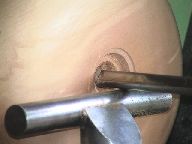gidon
Established Member
Hi
What's the best way of locking a nut to some studding - it's a M8 stud and nut. I can't lock it with another nut. Or is there something better? I don't have any welding equipment (still).
Thanks
Gidon
What's the best way of locking a nut to some studding - it's a M8 stud and nut. I can't lock it with another nut. Or is there something better? I don't have any welding equipment (still).
Thanks
Gidon

































